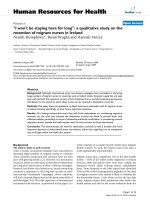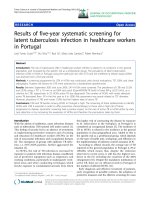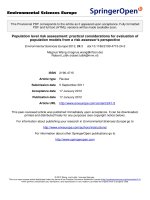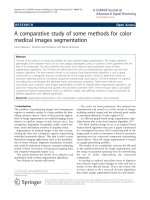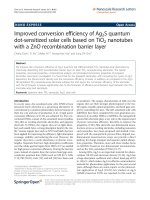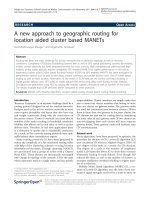Báo cáo toán học: " R bits user selection switch feedback for zero forcing MU-MIMO based on low rate codebook" docx
Bạn đang xem bản rút gọn của tài liệu. Xem và tải ngay bản đầy đủ của tài liệu tại đây (392.32 KB, 43 trang )
This Provisional PDF corresponds to the article as it appeared upon acceptance. Fully formatted
PDF and full text (HTML) versions will be made available soon.
R bits user selection switch feedback for zero forcing MU-MIMO based on low
rate codebook
EURASIP Journal on Wireless Communications and Networking 2012,
2012:7 doi:10.1186/1687-1499-2012-7
Shiyuan Li ()
Qimei Cui ()
Xiaofeng Tao ()
Xin Chen ()
ISSN 1687-1499
Article type Research
Submission date 20 July 2011
Acceptance date 10 January 2012
Publication date 10 January 2012
Article URL />This peer-reviewed article was published immediately upon acceptance. It can be downloaded,
printed and distributed freely for any purposes (see copyright notice below).
For information about publishing your research in EURASIP WCN go to
/>For information about other SpringerOpen publications go to
EURASIP Journal on Wireless
Communications and
Networking
© 2012 Li et al. ; licensee Springer.
This is an open access article distributed under the terms of the Creative Commons Attribution License ( />which permits unrestricted use, distribution, and reproduction in any medium, provided the original work is properly cited.
R bits user selection switch feedback for zero forcing MU-MIMO based
on low rate codebook
Shiyuan Li
*
, Qimei Cui, Xiaofeng Tao and Xin Chen
Key Laboratory of Universal Wireless Communications, Ministry of
Education, Wireless Technology Innovation (WTI) Institute, Beijing
University of Posts and Telecommunications (BUPT), Beijing, P.R. China
*Corresponding author:
Email addresses:
QC:
XT:
XC:
Abstract
Channel feedback for multi-user (MU)-multiple-input multiple-output
(MIMO) has been widely studied and some results have been got with
random vector quantization scheme. However, while the low rate fixed
codebook feedbacks are adopted, the performance of zero forcing (ZF) MU-
MIMO will decrease as the unpredictable inter-user interference is
introduced because of quantized channel state information (CSI). To
decrease inter-user interference in low rate fixed codebook feedback, an
enhanced user selection switch (USS) feedback scheme for ZF MU-MIMO
is proposed in this article. In USS feedback, the extra USS information is
added after quantized CSI and received signal-to-noise ratio feedback. The
USS information indicates inter-user interference and it can be used in user
selection procedure to avoid large inter-user interference. Simulation results
show that the proposed USS feedback scheme is efficient to solve the
problems of unpredictable inter-user interference in conventional feedback
scheme with low rate codebook in ZF MU-MIMO.
Keywords: MU-MIMO; feedback; user slection; user pairing.
1. Introduction
It is well known that multiple-input multiple-output (MIMO) can make full
use of spatial diversity and enhance data rate by spatial multiplexing. In rich
scattering environment, the data rates increase linear with the minimal
antenna number of the base station (BS) and user equipment (UE) compared
to the single-input single-output (SISO) scheme [1]. Usually, BS equips more
antennas than UE, so the spatial diversity of MIMO system is not fully
utilized. To overcome this drawback, the multi-user MIMO (MU-MIMO)
technique is introduced. In downlink MU-MIMO transmission, the data
streams of multiple UEs are simultaneously transmitted from BS to UEs at
same time and frequency resource. Each UE demodulates its data only by his
own channel state information (CSI) and the data of other UEs are treated as
interference.
While BS and UEs know the perfect CSI, “Dirty Paper Coding” (DPC) [2–
6] is known to achieve the capacity of the MIMO downlink channel, but
DPC has very high complexity to be realized in actual system. To reduce the
complexity of coding, zero forcing (ZF) [7–10] is proposed as the sub-
optimal solution and the performance of ZF is close to DPC in many
scenarios [11].
ZF technique needs CSI between BS and UEs while performing user
selection and computing precoding matrix. The exact CSI can be got by
channel reciprocity in TDD system. However, BS only can get quantized CSI
by UE feedback in FDD system because the feedback channel has limited
rate. So, the signals of paired UEs cannot be perfectly separated by ZF
precoding and UE will receive the unwished signals of other paired UEs
which is called inter-user interference. Hence, the MU-MIMO performance
will be decreased with the quantized CSI in FDD system [12, 13]. Some
important conclusions with limited feedback for MU-MIMO have been
got[14–19], and these studies show that the quantization bit scales linear with
number of transmit antennas and logarithmic with received SNR of UE while
a constant performance gap are hold compare to perfect-CSI.
In former research, the derivation of sum-rate is based on the assumption
of random vector quantization (RVQ), which means the codebook of each
UE is randomly generated and they are uniformly distributed on the unit
sphere. There are some disadvantages for RVQ scheme in the actual
communication system:
(1) It needs a great deal feedback bits in the case of high SNR and large
number of transmit antennas [16–18]. For example, while SNR is 10 dB with
4 transmit antennas, it needs about 14 bits (16,384 codebooks) and while
SNR is 20 dB with 8 transmit antennas, it needs about 35 bits
(34,359,738,368 codebooks).
(2) The codebook needed in RVQ scheme should randomly be generated
by UE before CSI feedback, and then the codebook is sharing with BS
through feedback channel. So, the large codebook number will also increase
feedback overhead of codebook sharing, the computational complexity of
codebook generation, and cache costs of codebook storage.
(3) RVQ needs different quantized bits for different SNR cases, so it will
bring some design problems. For examples, if the feedback bits are fixed, it
will cause waste for low SNR case and not enough for high SNR case. If
feedback bits are flexible, new codebook will be retransmitted while SNR
changed and it will decrease the effects of user selection between UEs with
different SNR.
Moreover, most of the current communication system adopt small
codebook size and fixed codebook structure, which both known by UE and
BS, to reduce the system complexity feedback overhead. In this feedback
scheme, the former performance analysis for RVQ will be not suitable. In
low rate fixed codebook feedback scheme, the interference between paired
users is the key problem and conventional feedback and user selection
scheme have on mechanism to avoid large inter-user interference. To
overcome this drawback in low rate fixed codebook feedback scheme, the
reasons of large inter-user interference are analyzed detailed and an enhanced
scheme named user selection switch (USS) feedback is proposed here. The
USS feedback adds some extra information besides CSI and SNR to show
the inter-user interference while performing ZF MU-MIMO transmission.
With USS information, BS can avoid large inter-user interference in MU-
MIMO transmission in user selection procedure and enhance MU-MIMO
performance.
The rest of the article is organized as follows. Section 2 introduces
conventional MU-MIMO transmission model and analyzes the problem of
low rate fixed codebook feedback scheme. Section 3 proposes USS feedback
to enhance MU-MIMO performance and gives related user selection
procedure. Section 4 gives the numerical simulation to verify the
performance enhancement. Section 5 provides some conclusions.
2. System model
In this article, the single cell MIMO downlink channel is considered, in
which the transmitter has M antennas and each UE has 1 antenna. Each user
only receives one data stream, and at most M users can be communicated at
the same time. The system model is shown in Figure 1. In conventional
feedback, only SNR and CSI are fed back to BS.
The signal received by a single user
i
can be represented as
i i i i i i j i
j i
y g H x g H x n
≠
= + +
∑
, (1)
where
i
g
is pathloss between BS and
UE
i
,
1
M
i
H C
×
∈ is the normalized channel
matrix between BS and
UE
i
,
i
x
is the transmitted signals with an average
power constraint
2
{|| || }
i i
E x P
=
,
|| ||
⋅
stands for norm operator,
i
P
is the power
constraint of each user’s data stream,
i
n
is the additive white Gaussian noise
with
2
σ
variance, and
i
y
is the signal received by
UE
i
.
The procedure of conventional ZF MU-MIMO is as follows [10, 18].
2.1. Quantized CSI feedback
It assumed that each user knows perfect CSI and normalized it to a unit
norm vector
i
H
. The quantization vector is chosen from a fixed codebook of
size
2
B
N
=
1
1
{ } , ( , 2 )
M B
N j
C c c c C N
×
= ∈ =L . (2)
The codebook C is designed offline and both known to the BS and UE. UE
will select a vector from codebook according to the minimum distance
criterion as following equation,
1
arg
max
H
i j
j N
k H c
≤ ≤
= . (3)
Then the index
k
is fed back to BS, and BS treats
i k
w c
=
as the channel
matrix
i
H
of
UE
i
.
2.2. SNR Feedback
Each user will feed back its received SNR with assumption of single user
transmission. The SNR of users is
2
2
2
SNR /
i i i
i i i
g H x
g P
σ
σ
= = . (4)
UE can measure it by reference signals (RS), as the RS sequence and its
power are known to UE. In the practical system, this information is quantized
with small number of bits. In order to concentrate on the effect of CSI
quantization and user selection, it assumes that the SNR is directly fed back
without quantization.
2.3. User selection
After BS received feedback, it will select some paired users from serving
user set
1
{UE , , UE }
K
U = , which is correspond to all the users served by BS.
The number of selected users is determined by higher layer and must be no
more than m which is the number of transmit antennas. There have been
many proposed user selection criteria [20–25] and the basic principle is to
maximize the total throughputs of the paired users. It is known that in MIMO
transmission, the higher throughput will be gotten with the smaller channel
correlation between paired users. So, in the simulation of conventional MU-
MIMO in the article, BS will select users which have the minimal spatial
channel correlation between each other. That’s means the maximum
correlation between selected users will be minimal in all possible MU-
MIMO user combinations. The user selection criterion can be expressed as
, ;
| |
max
min
H
i j
V i j V i j
H H
∈ ≠
, (5)
where
| |
⋅
stands for absolute value,
( )
H
⋅
stands for Hermite transpose,
V
is
paired user set in which the users are scheduled together to form MU-MIMO.
2.4. ZF precoding
After the paired user set V is determined, BS will calculate the precoding
matrix for these paired users. The precoding matrix is computed by ZF
methods:
( )
1
1 M
M
w
p p
w
+
=
L M , (6)
where
i
p
is precoding vector of
UE
i
,
i
w
is the quantized CSI of
UE
i
,
( )
+
⋅
stands for pseudo-inverse operation.
So, the received signals of uses in set V are
( )
1 1
1 1 1
1 M
M M M
M M
g H
y x n
p p
y x n
g H
= +
M M L M M
. (7)
Here, the total power should be reallocated among multiple users’ data
stream. The power adjustment includes coefficient scaling of users’
precoding vector and power allocation of users’ data stream. The received
signals of users change to following equation:
1 1
1 1 1 1
1
1
M
M
M M M M
M M
g H
y s n
p p
y s n
g H
β
α α
β
= +
M M L M M
, (8)
where
i
α
is coefficient scaling factor,
i
β
is power allocation factor, and
i
s
is
transmit symbols with unit variance. The total power should be no more than
max transmit power
total
P
, and the constraint is
2
2
total
2
1
M
i
i
i
i
p P
β
α
=
=
∑
, (9)
The received signal of each user is
1,
M
j
i
i i i i i i i j j i
j j i
i j
y g H p s g H p s n
β
β
α α
= ≠
= + +
∑
, (10)
where
i
i i i i
i
g H p s
β
α
is wanted signal and
1,
M
j
i i j j
j j i
j
g H p s
β
α
= ≠
∑
is inter-user
interference.
2.5. MU-MIMO performance with conventional feedback
The user SNR of MU-MIMO is
2
2
2
2
2 2
2
1,
|| ||
MU_SNR
|| ||
i
i i i
i
i
M
j
i i j i
j j i
j
g H p
g H p
β
α
β
σ
α
= ≠
=
+
∑
. (11)
The total throughput is
MU
1
log(1 MU_SNR )
m
i
i
R
=
= +
∑
. (12)
2.6. The problems of conventional feedback
In the conventional feedback scheme, BS and UE cannot know the
MU_SNR
clearly. For
UE
i
, it knows its channel matrix
i
H
, but does not know
the channel of paired users. For BS, it knows paired users, but does not know
exact channel matrix of UEs. So, the
2
|| ||
i j
H p
cannot be known for BS and
UE. Hence, the transmitting rate
R
is evaluated in conventional user
selection.
Usually
R
is evaluated with the assumption of no inter-user interference,
which means
2
|| || 0
i j
H p
≈
. But for the paired user, the inter-user interference
may be very large and lead the performance decrease heavily, while
2
|| || 0
i j
H p
. In user pairing, BS does not know the exact inter-user
interference, so it has no mechanism to avoid large inter-user interference in
user selection criteria.
The large inter-user interference will decrease throughput largely. For
example, if the inter-user interference
2
|| ||
i j
H p
is more than 0.0833 in the
configuration of 2Tx, 2 paired UE, 10 dB SNR, the sum rate of MU-MIMO
will less than SISO transmission. And the inter-user interference should be
smaller in high SNR region than in low SNR region. Unfortunately, the inter-
user interference usually is not small enough for MU-MIMO requirement in
low fixed codebook scheme. Figure 2 shows the CDF of inter-user
interference with 4 bits DFT codebook while the quantized CSI of paired
user is orthogonal. It can be seen that about 50% of inter-user interference are
more than 0.1; so many users are paired with large inter-user interference.
Although the MU-MIMO will not work well with the large inter-user
interference, the conventional feedback and user selection method cannot
provide enough information to distinguish large inter-user interference and
small inter-user interference.
These will cause two serious problems:
(1) The performance gain of MU-MIMO will decrease, especially in high
SNR case. Figure 3 shows the MU-MIMO (two paired users) performance of
4 bits feedback with DFT codebook, compared to SISO case and perfect CSI
feedback. It can be seen that MU-MIMO with perfect CSI feedback has very
high rate about double of that in SISO case. But for low rate quantized
feedback (4 bits), the performance gain falls largely compare to perfect CSI
feedback, as the CSI is the quantized version with low codebook size. The
performance gain is little at high SNR region because the inter-user
interference of paired users is randomly in quantized feedback with
conventional user selection methods, and MU-MIMO performance is
sensitive to inter-user interference in high SNR case.
(2) While the quantized bits increase, the performance enhancement may
not be obvious for some codebook types. Figure 4 shows the sum data rate of
MU-MIMO quantized with DFT codebook of different bits. It can be seen
that while the number of quantized bits increase from 2 to 3 bits the
performance enhancement is obvious, and performance enhancement is little
while number of quantized bits increase from 3 to 6 bits. Concluded from the
growth trend, when the number quantized bit is more than 6 bits, the
performance is near to case of 6 bits. So, increasing codebook size is no use
to enhance MU-MIMO performance. The reason is that the increasing
number of quantized bits cannot decrease the inter-user interference of paired
users for fixed codebook structure unlike RVQ feedback scheme.
3. Algorithm
To decrease the bad effect of random inter-user interference in low rate
fixed codebook feedback scheme, a novel USS feedback scheme is proposed.
In the USS feedback, extra USS information is added after CSI feedback to
show the inter-user interference. And this information is used in user
selection algorithm to avoid large inter-user interference. The detailed
process of the proposed scheme is elaborated as follows.
3.1. Grouping quantized codebook
In MU-MIMO transmission, the paired users are usually selected with
small correlation between their channels. In USS feedback scheme, codebook
C
is divided into several groups, and only the users whose quantized CSI
from the same group can be paired together. The codebook
C
is divided as
follows:
1
{ , , } ( ; ; , , 1, , )
H
k k kl ki kj
C c c c c R ki kj ki kj k N
= < ≠ = , (13)
where
k
C
is subset of codebook
C
satisfied
1, ,
k
k m
C C
=
= U and
1 2
( 1 2)
k k
C C k k
= ∅ ≠I ,
ki
c
is element of codebook
C
,
m
is number of groups,
l
is element number of
subset,
N
is codebook size with the relevance
*
N l m
= ,
R
is correlation
threshold between code vector in subset, which means the correlation
between any two paired users are no more than
R
.
Only the users which their feedback belong to same group can be paired
together, so the correlation between any two paired users are no more than
R
.
At most
M
users can be transmit at same time in MU-MIMO, so lets
l M
≥
,
and all the
M
users can be selected in the same set. In the simulation of this
article, the DFT codebook is adopted with setting
l M
= and
0
r
=
, as DFT
codebooks are naturally separated into orthogonal groups, which has
M
orthogonal vectors.
3.2. USS information feedback
In USS feedback scheme,
( 1) *
l r
− additional bits named USS information
are fed back to BS besides CSI and SNR, and this information is used to
indicate the MU-MIMO performance. In sub-codebook groups, user can be
paired with other
( 1)
l
−
vector, so USS information uses
r
bit(s) for each
vector to show the MU-MIMO performance while user is paired with this
vector. The feedback contents are
1 1
(USS , , USS )
l −
and
USS
i
corresponding to
the ith vector in sub-codebook except the vector which user is fed back. For
example, if
1
r
=
, the user can be paired with ith vector while USS
i
= 1, and
the user cannot be paired with ith vector while
USS 0
i
=
.
The value of USS information is relative to transmission and feedback
configuration, such as number of paired user
m
and USS information bits
r
.
The details of the value calculation will be shown in Section 3.4 for different
configurations.
3.3. User selection procedure
In USS feedback scheme, the user selection will use USS information to
avoid large inter-user interference. The step is as follows:
(1) BS defines three sets: serving user set
1
{UE , , UE }
K
U = , corresponding to
all the users served by BS; (2) user CSI set
1
{ , , }
K
W w w
= , corresponding to
users’ CSI; (3) paired user set MU
= ∅
, corresponding to the users scheduled
together to adopt MU-MIMO. BS sets the number of paired users (more than
1 and no more than the number of transmit antennas).
(2) BS selects first two users
( , )
i j
from set
U
. The UE
i
and UE
j
should
satisfy the conditions: (a) their CSI feedback should be in the same codebook
group
k
C
, that means ,
i j k
w w C
∈ ; (b) the USS information for paired vector
should not be equal to zero, that means
1 2 1 2
(USS 0, USS 0, , )
il jl kl j kl j
c w c w
> > = = ; (c)
the summation of USS information for paired vector should be maximum in
all users which satisfy conditions (a) and (b), that means
1 2
UE ,UE satisfy (a) and (b)
( , ) (USS USS )
max
i j
il jl
i j = + .
If the two users can be found, BS will put them into paired user set
MU {UE , UE }
i j
= , and remove them from serving user set
{UE , UE }
i j
U U= − .
Otherwise, user pairing will be stopped and single user mode will be
adopted.
(3) If the number of paired user is enough, start ZF procedure to compute
precoding matrix. Otherwise, select the next user o from set U. The UE
o
should satisfy the conditions: (a) its CSI feedback should be in codebook
group
k
C
, same to users in set MU, that means
o k
w C
∈ ; (b) the USS
information for paired vector of UE
o
and users in set MU should be more
than zero, that means
(USS 0,USS 0, , , UE MU)
oli ilo kli i ilo o i
c w c w> > = = ∈ ; (c) the
summation of USS information for paired vector should be maximum in all
users which satisfy conditions (a) and (b), that means
oli ilo
UE satisfy (a ) and (b)
UE MU
( ) (USS USS )
max
o
i
o
∈
= +
∑
.
If the user
o
can be found, BS will put it into paired user set
MU=MU+{UE }
o
,
and remove them from serving user set
{UE }
o
U U= − . Otherwise, user pairing
will be stopped and start ZF procedure to compute precoding matrix for the
users in set MU.
(4) If the number of paired user is enough, start ZF procedure to transmit
users’ data. Otherwise, go to step 3 to select another user.
3.4. USS value calculation
The value of USS information is relative to the number of paired user m
and USS information bits r. In this section, different cases will be discussed
separately.
(a)
1
r
=
and
2
m
=
For two paired users, the SNR for each user can get from Equation (11),
2
2
2
2
2 2
2
|| ||
MU_SNR
|| ||
i
i i i
i
i
j
i i j i
j
g H p
g H p
β
α
β
σ
α
=
+
, (14)
where
i
α
is coefficient scaling factor,
i
β
is power allocation factor. The total
power should no more than max transmit power
total
P
, and the constraint is
2 2
1 2
1 2 total
1 2
p p P
β β
α α
+ = .
The precoding vector can be gotten from Equation (6),
( )
( ) ( ) ( )
2
1
2 2 1
1
1 2 1 2 1 2 1 2
2
2
2 2
2
1 2 1
1 2 1 2
1
, , , ,
( )
H
H H H H H H
H
H
w w w
w
p p w w w w w w
w
w w w
w w w w
−
−
= =
−
−
. (15)
Define the correlation of vector:
1 2
H j
w w e
φ
σ
= . So, the precoding matrix
changes to
2
2
2
2
( )
( )
H j H
j i j
i
i j
w w e w
p i j
w w
φ
σ
σ
−
−
= ≠
−
(16)
Each user knows its channel matrix and the vector of paired user is
selected in subset
k
C
. So, user can calculate the exact SNR of MU-MIMO for
each vector in set
k
C
.
The equation can be simplified with following assumptions: (1) usually the
codebook is normalize vector, that means
2
1
i
w
=
; (2) normalize precoding
vector for each users, that means
2
2
i i
p
α
= ; (3) power is equally allocated in
the paired users, that means
2
total
/
i
P m
β
= , where
m
is number of paired users;
(4) define correlation of CSI quantized as
ai
j
H
i i i
H w a e
φ
= ; (5) define inter-user
interference as
( )
bij
j
H
i j ij
H w b e i j
φ
= ≠
. By substituting Equation (16) into Equation
(14), we can get
2
2 2 2
2
2
2 2 2
(1 )
2
MU_SNR
(1 )
2
bij
ai
bij
ai
j
j
j
i ij
i total
i
i
j
j
j
ij i
i total
i
j
a e e b e
g P
p
b e e a e
g P
p
φ
φ
φ
φ
φ
φ
σ
σ
σ
σ
σ
−
−
−
=
−
+
−
. (17)
This result can be used in USS information calculation. In USS feedback
scheme, a correlation threshold
R
is used in codebook subset. It means in
above equations that the correlation
σ
must be no more than
R
as the paired
vector is selected from same subset. With different value of
R
, it can be
divided into two categories:
(a-1)
0
R
≈
. In this case, it can be thought that the paired vector is
orthogonal, so the correlation
σ
can be tread as zero. The precoding matrix
changed to
H
i i
p w
= , and Equation (17) can be simplified as:
2 2
total
2 2 2
total
/ 2
MU_SNR
/ 2 2 /
i i i
i
i ij i ij i
g P a a
g P b b SNR
σ
= =
+ +
, (18)
where
SNR
i
is the measured SNR defined in Equation(4).
So, throughput of UE
i
is
2
2
log(1 MU_SNR ) log 1
2 / SNR
i
i i
ij i
a
R
b
= + = +
+
(19)
Because user does not know the vector which BS will be schedule in user
pairing, the actual transmit rate cannot be known. In USS feedback scheme,
all the paired vectors are in one subcodebook
1
{ , , }
k k kl
C c c
= , and for one UE,
the number of candidate pairing vector is
1
l
−
. So, for each candidate pairing
vector in subcodebook, user will evaluate its throughput when this vector is
selected as paired vector, and the USS information is calculated based on this
evaluated throughput.
User assumes that the paired user has the same correlation of quantized
CSI
a
and the same inter-user interference level
b
, so the evaluated sum
throughput is
2 ( )
kj i
R R j i
= ≠
. If the sum throughput for the vector
kj
c
is more
than MISO throughput
su
log(1 SNR)
R = + , set
USS 1
kj
=
, which means the
performance is better while UE
i
paired with vector
kj
c
, otherwise set
USS 0
kj
=
,
which means the inter-user interference is large while UE
i
paired with vector
kj
c
and UE
i
should avoid to pair with this vector.
(a-2)
0
R
>
. In this case, the correlation
σ
should be considered. Equation
(17) changed to
2
2 2 2
2 2 2 2 2
2
2 cos( )
MU_SNR
2 cos( ) 2(1 ) / SNR
2(1 ) /SNR
bij
ai
bij
ai
j
j
j
i ij
i ij i ij ai bij
i
j
j
j
ij i i ij ai bij i
ij i i
a e e b e
a b a b
b a a b
b e e a e
φ
φ
φ
φ
φ
φ
σ
σ σ φ φ φ
σ σ φ φ φ σ
σ σ
−
−
+ − + −
= =
+ − + − + −
− + −
(20)
From CSI quantization criterion, it is known that
a
is near to 1. Usually,
the correlation
σ
is set near to 0 to enhance the MU-MIMO performance and
the inter-user interference
b
will be small guaranteed by user selection
procedure. So, it can be thought that
b a
σ
<<
. Equation (20) can be simplified
as
2
2 2 2 2
MU_SNR
2 cos( )) 2(1 ) / SNR
i
i
ij i i ij ai bij i
a
b a a b
σ σ φ φ φ σ
≈
+ − + − + −
. (21)
The USS information calculation is same to the case of
0
R
≈
. The
difference is that
MU_SNR
i
will use Equation (21) instead of Equation (18) in
USS calculation.
(b)
1
r
=
and
2
m
>
If more than two users are paired together to form MU-MIMO, then the
SNR of MU-MIMO user will be decreased compare to two paired users, as
the inter-user interference is
1
m
−
times and the power allocation of each user
is also decreased. It assumes that the power is equally allocated to each user
and the paired users have the same correlation of quantized CSI
a
and inter-
user interference level
b
for each paired vector.
For the case of
0
R
≈
, the evaluated MU-MIMO SNR changed to
2
2
MU_SNR
( 1) / SNR
i
i
ij i
a
m b m
=
− +
. (22)
While
0
R
>
, the evaluated MU-MIMO SNR changed to
2
2 2 2 2
MU_SNR
( 1)( 2 cos( )) (1 ) / SNR
i
i
ij i i ij ai bij i
a
m b a a b m
σ σ φ φ φ σ
≈
− + − + − + −
. (23)
The evaluated sum rate changed to
log(1 MU _ SNR )
kj i i
R mR m= = + . (24)
The USS information calculation is same to the case of
2
m
=
. The
difference is that
MU_SNR
i
uses Equations (22) and (23) for different cases
and the sum throughput
kj
R
uses Equation (24).
(c)
1
r
>
If each USS is more than 1 bit, it should be quantized by
2
r
rank. The sum
throughput
kj
R
is evaluated and it is mapped into region from
lower
R to
upper
R
with
r
bits. The sum rate
kj
R
is calculated same to cases (a) and (b). The
lower bound is defined as single user performance
lower
log(1 SNR)
R = + , as sum
rate of MU-MIMO should be more than single user transmission. The upper
bound is defined as the users paired with orthogonal vectors with no inter-
user interference:
2
upper
2 2 2
log 1
( 1)( ) (1 ) / SNR
i
i i
a
R m
m a m
σ σ
= +
− + −
. (25)
The quantization is performed as follows:
(1) if
lower
kj
R R≤ , set
USS 0
kj
=
;
(2) if
upper
kj
R R≥ , set
USS 2
r
kj
=
;
(3) if
lower upper
kj
R R R< < , set
lower
upper lower
USS 1 *2
kj
r
kj
R R
R R
−
= +
−
, where
⋅
is floor
function.
3.5. Feedback overhead
In USS feedback scheme, the extra USS information is added after
quantized CSI, and the feedback overhead is changed. So, the overhead of
USS feedback, conventional feedback, and RVQ feedback is analyzed in this
section. As discussed above, it assumed that (1) the codebook size is
2
B
N
=
;
(2) the quantization vector
1
M
j
c C
×
∈ ; (3) UE will feed back one quantized CSI
in each feedback period.
For conventional feedback, only a quantized CSI is fed back to BS in each
feedback period, so the feedback overhead is
B
bits in a feedback period.
For USS feedback, in each feedback period, the extra USS information is
fed back to BS besides the quantized CSI. As discussed in Section 3.4, it has
l
elements in subset and
r
bits USS information for each element in subset.
So, the feedback overhead is
( 1)*
B l r
+ − bits in a feedback period.
For RVQ feedback, a quantized CSI is fed back to BS in each feedback
period. Besides, the random codebook should be shared between BS and UE,
and this codebook is randomly generated by UE then fed back to BS through
feedback channel. It is assumed the random codebook can be used in
q
periods and the 16 bits quantization with short floating point number is
adopted for each complex element of codebook. So, the initialization
overhead is
* *16 * 2
N M , and this overhead cover to each period is
* *16 * 2 /
N M q
. The totally feedback bits in a feedback period is * *32 /
N M q B
+
.
The overhead comparison of the three methods is list in Table 1.
